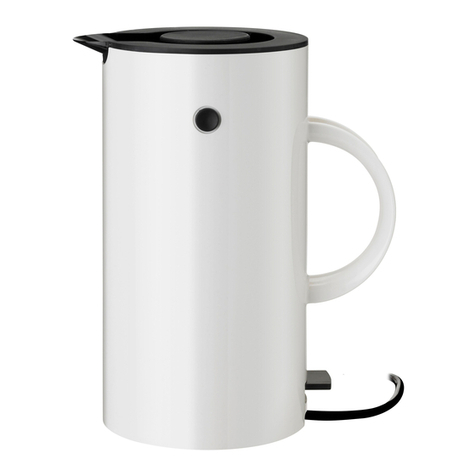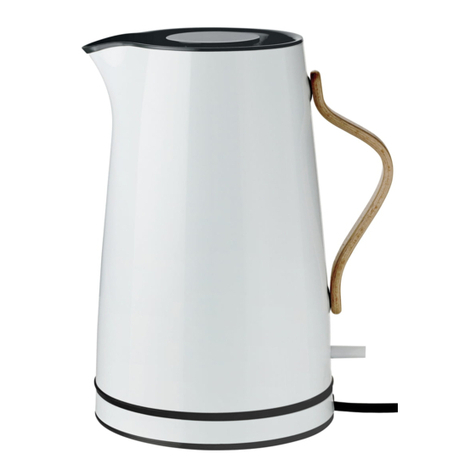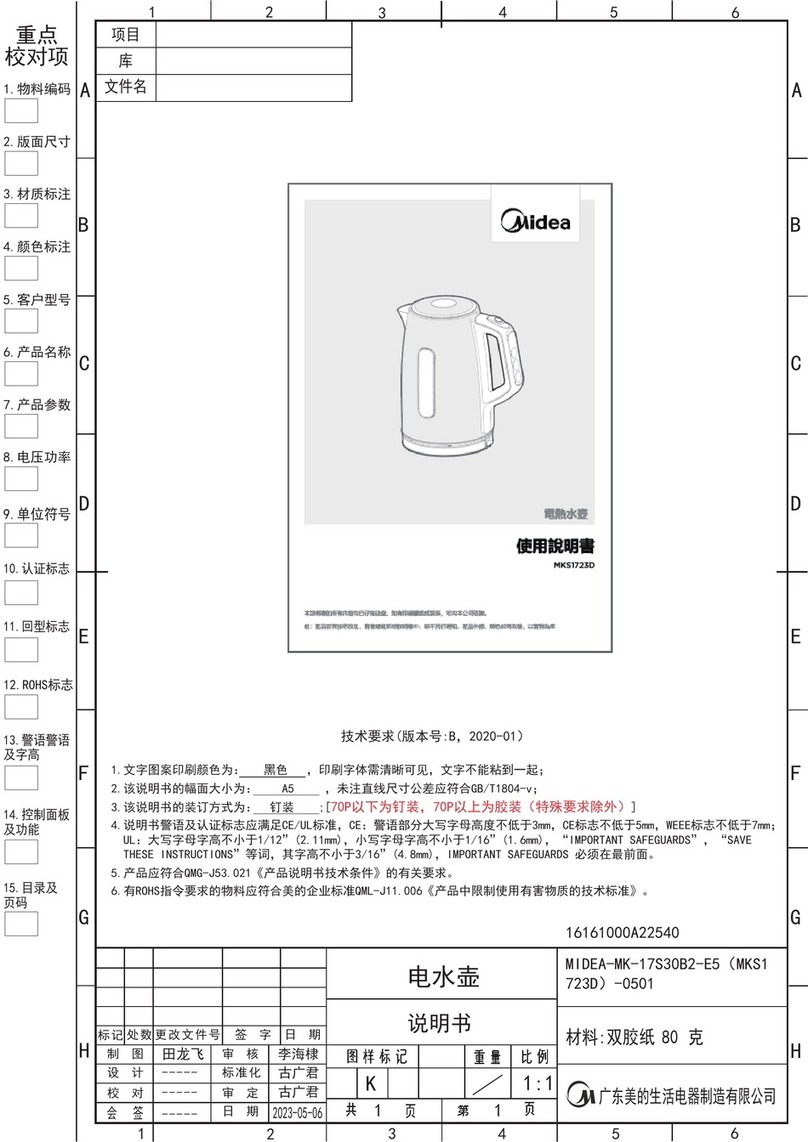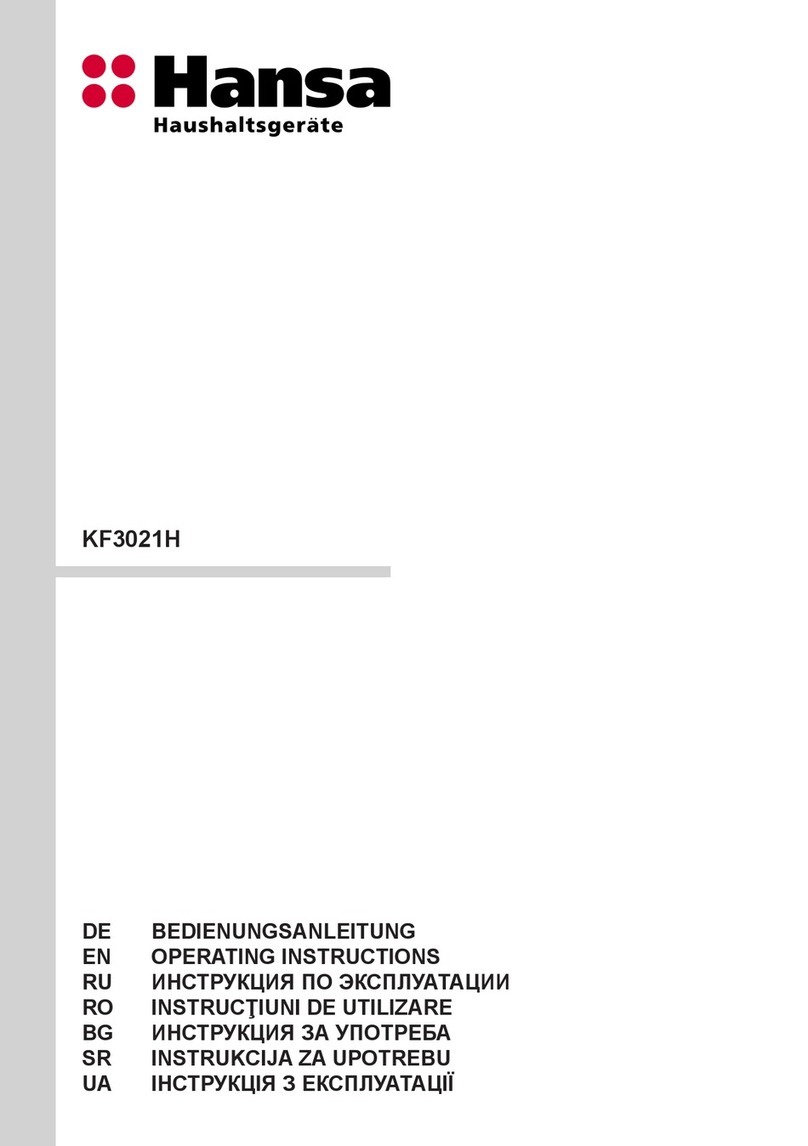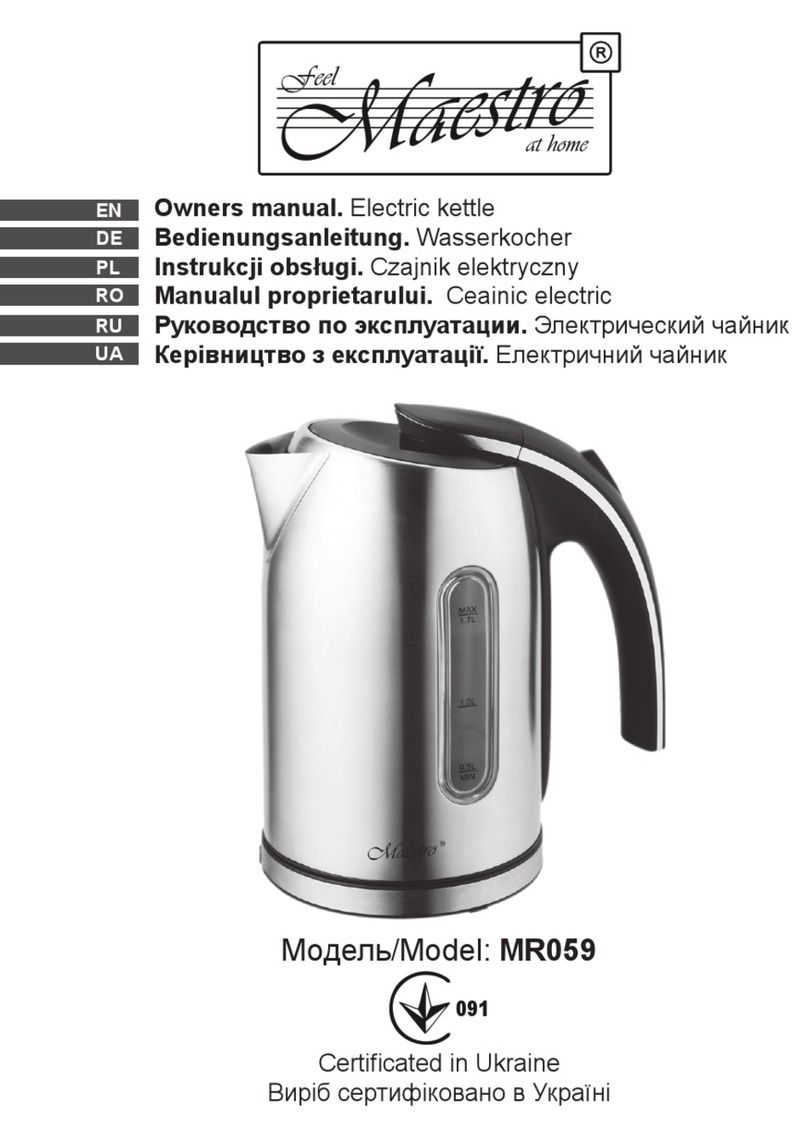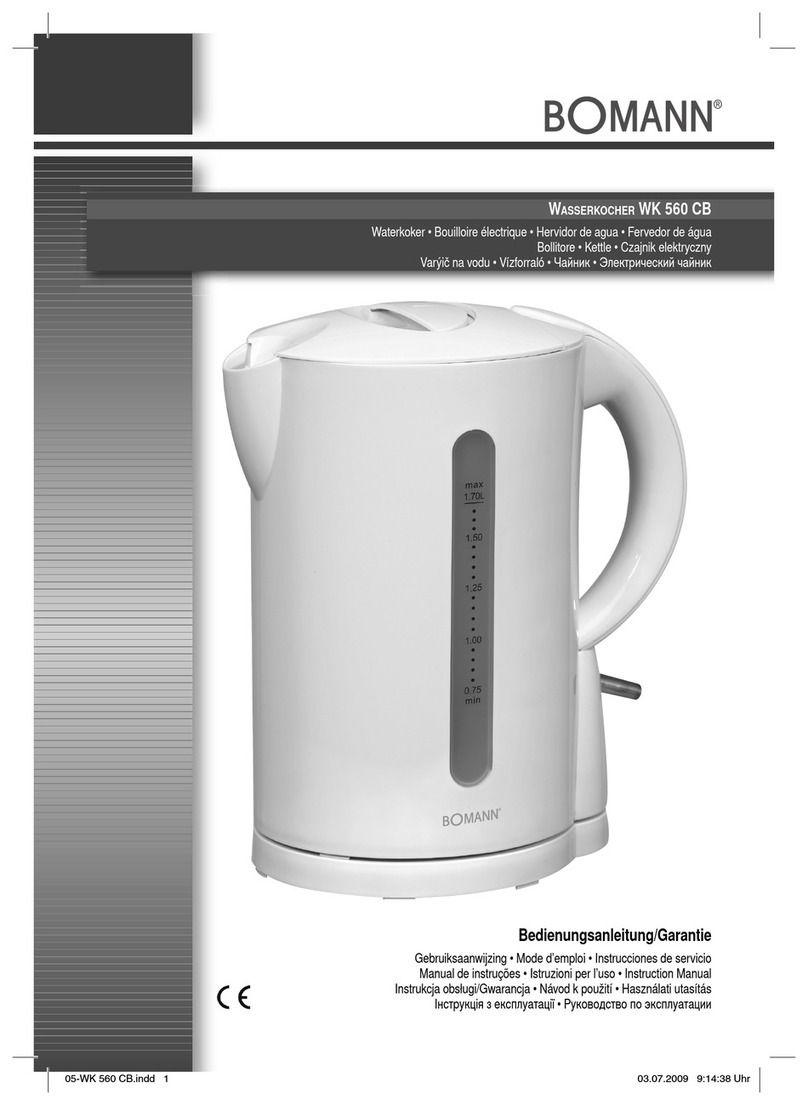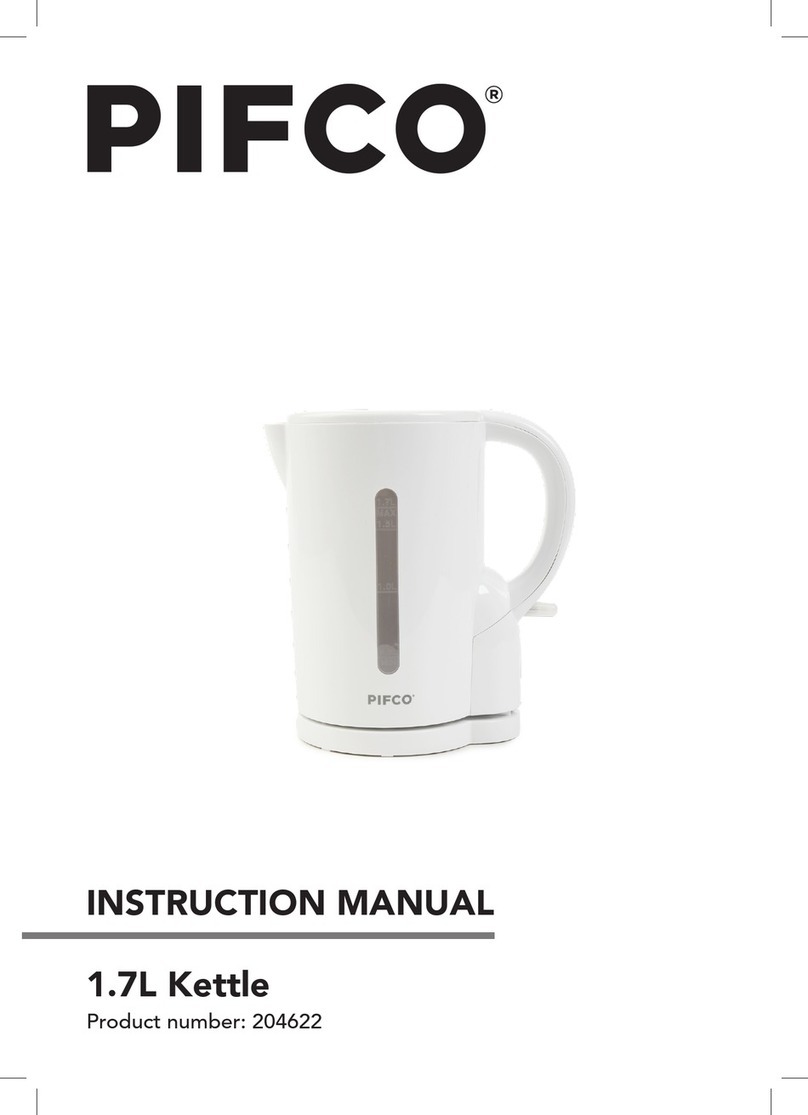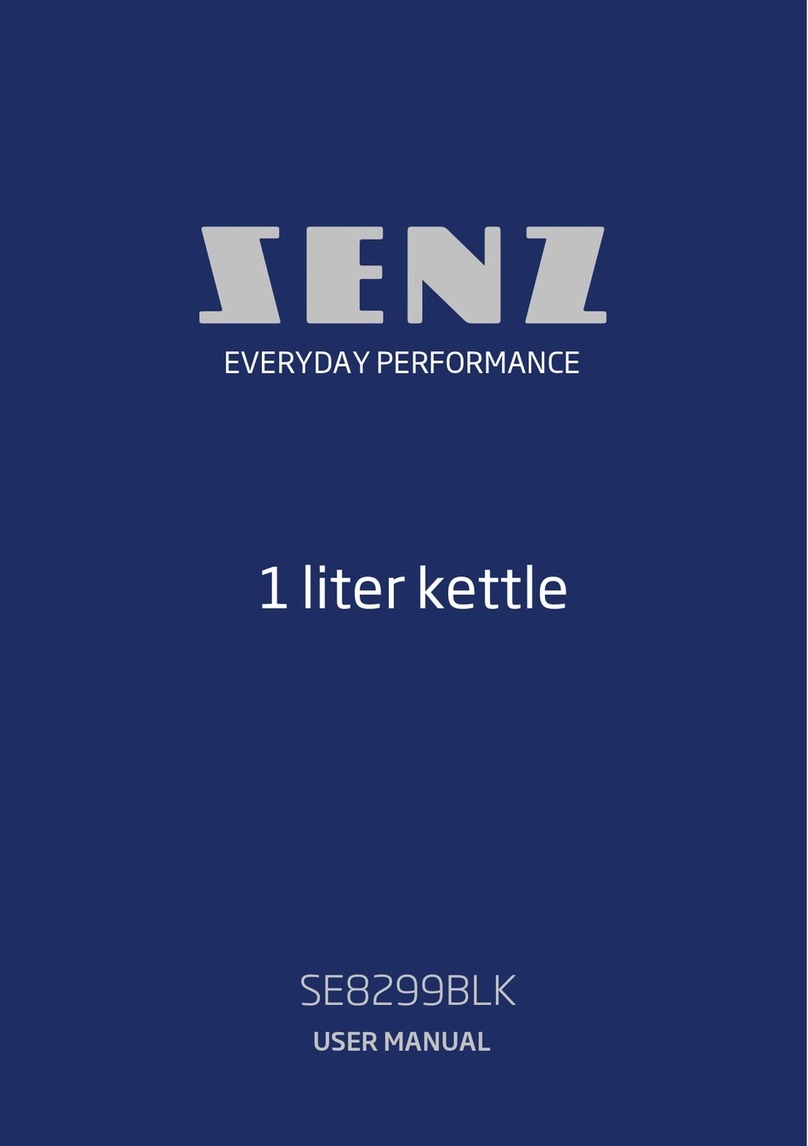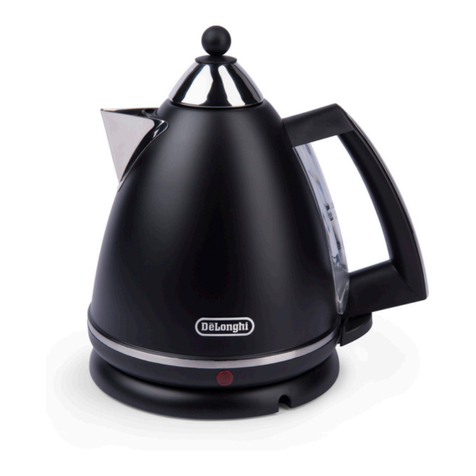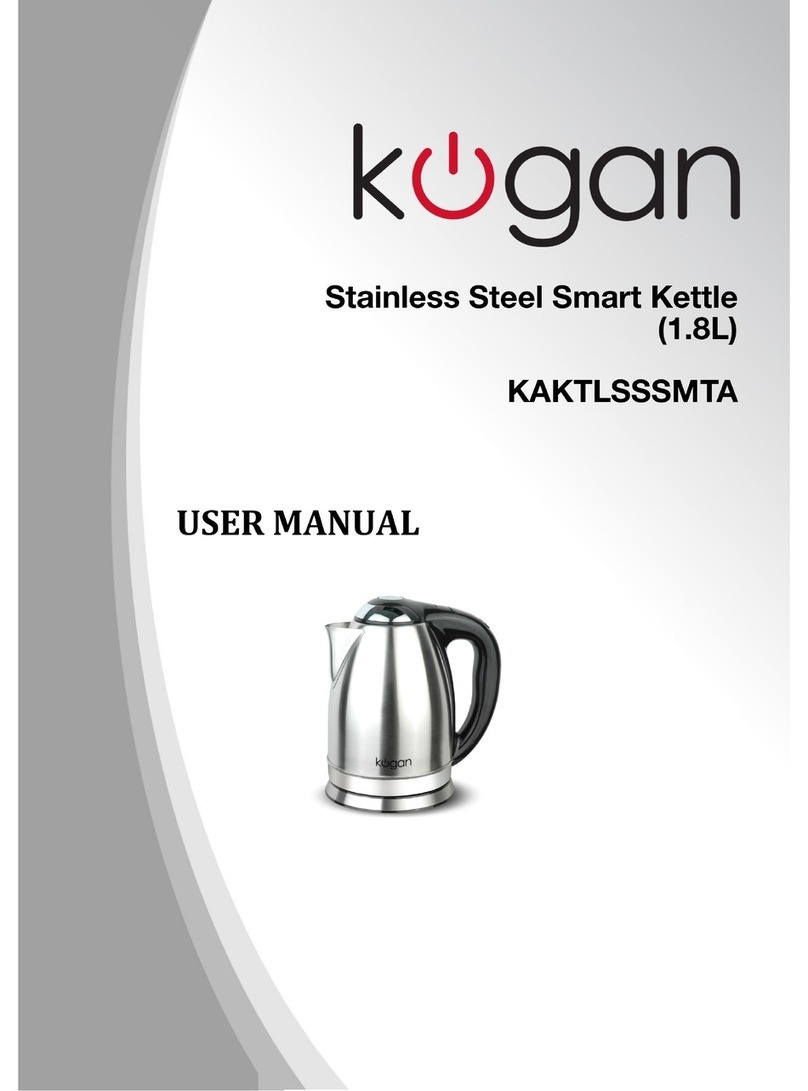stelton Emma User manual

58
UK
Lid
Cordless jug
On/o switch
Power conductive base
Plug
Image 1

59
UK
Image 2
Fill with water only up to the MAX mark for 1.2L.
·Cordless kettle
·Heat-insulated, double-walled steel jug
·Jug in stainless steel
Image 3
On/o switch
·Lights up when kettle is on
·With dry-boil protection. The electric kettle and light
turn o automatically when the water reaches boiling
point (100 °C) or if the kettle boils dry of water.
Image 4
Unplug when the kettle is not in use.
Image 5a
Descaling the lter. Take the top
of the lter and pull up carefully.
Image 5b
Use a washing-up brush or cloth and
hot water to clean the lter for limescale.

60
UK
The steel jug can be placed on the base from all angles.
Keep the cord as short as possible. Any excess cord
should be rolled up under the base.
IMPORTANT: Before lling the kettle with water, remove
from base. Only ll up to the steel jug’s MAX mark on 1.2 L
(see image 2) and push the lid rmly in place.
WARNING: If the electric kettle is lled above the MAX
mark see image 2), boiling water may spray out of the
kettle when in use.
The rstrsttime the electric kettle is used, water should
be boiled three times in the kettle before drinking. This
ensures that any minor impurities from production are
removed.
The electric kettle is switched on using the on/o switch
under the handle (see image 2).
When the water boils (100 °C), the electric kettle auto-
matically switches o and the light goes o. To boil more
water, the switch needs to be switched on again. The
automatic dry-boil protection prevents accidental boiling
when the steel jug is placed back on the base aer pour-
ing. Always unplug when the kettle is not in use.
IMPORTANT: Always check the lid is securely in place be-
fore switching the kettle on. The lid will click when pressed
into place. If the lid is not clicked into place, the kettle’s
automatic dry-boil protection will not work optimally. The
kettle must not be used without a lid as there is a risk of
boiling water spraying out. Should any irregularities occur
with the dry-boil protection, such as the kettle switching
o before reaching 100 °C or aer, leave the kettle to
cool; see section on maintenance.
Dry-boil protection
The electric kettle has an inbuilt dry-boil protection,
which means the heat element disconnects automati-
cally if the kettle has limescale, if it is switched on without
water in it, or if it boils dry. Should this happen, check
whether there is a build-up of limescale at the bottom of
the kettle and then descale as required. Test the kettle
by lling with water and plugging the apparatus in. If the
electric kettle continues to disconnect before boiling
point, take the kettle and base to the dealer you bought
it from for an inspection.
Maintenance
Descaling the lter
The electric kettle is supplied with a removable limescale
lter, which is placed in the spout. The lter prevents limes-
cale sediment in the water from pouring into the cup. It
is important to clean the limescale lter before too much
limescale builds up as otherwise the water cannot pass
through the lter and will instead pour out along the sides
of the lid, which increases the risk of scolding.
The lter is easily removed from the steel jug by pulling it
upwards. Any limescale on the lter can be brushed o
under running water with a washing-up brush or cloth.
Alternatively soak the lter in household vinegar or des-
caling uid. Aer cleaning with clean water, secure the
lter back in its place.
Cleaning the jug
Wipe the outside of the jug with water and detergent us-
ing a so, damp cloth. Dry using a so cloth or tea towel.
Never use scouring powder or other cleaning agents with
an abrasive eect, as this will scratch the surface.
Descaling the kettle
The electric kettle must be descaled regularly and
cleaned from limescale sediment:
Normal maintenance. Check weekly that the kettle
does not have a limescale build-up. We recommend
only boiling as much water as is needed. You then avoid
water being le in the kettle, which increases the amount
of limescale sediment. You also save electricity.
Descale as required. Use one of the following methods:
·Method 1: To remove mild limescale sediment, once a
week ll with clear household vinegar until it covers the
bottom of the steel jug. Leave the steel jug for a couple
of hours, empty and rinse well. Tip: the descaling pro-
cess is accelerated by heating the liquid to 50–60 °C.
·Method 2: To remove tough limescale sediment, ll
with 0.25 L clear household vinegar and 0.75 L water.
Switch on the kettle and let it boil. Leave it to cool for 15
minutes, then boil again twice.
Once cleaned, boil water in the kettle another three
times before drinking. This ensures that any remnants of
the descaling liquid are removed from the kettle.
If limescale still remains aer descaling, make sure the
kettle is descaled more frequently.
IMPORTANT: Only use descaling uid and household
vinegar to descale the kettle. Never use sharp objects
to clean or descale the heat plate at the bottom of the
steel jug. If the jug is not descaled regularly, it can lead
to the heat element or the jug becoming damaged. This
type of damage is not covered by the guarantee.
SAFETY
Read the instructions thoroughly before use and store
them for later use.
Connect the Emma electric kettle to 220–240 V and only
use the kettle for boiling water.
The electric kettle is for household use only, not commer-
cial use (e.g. in an industrial kitchen). Should the kettle
be used for other purposes, or should the kettle not be
used in accordance with the instructions, the user shall
bear full responsibility for any consequences. The right to
complain as a result shall not cover any damage to the
kettle or personal injury.
Always use the kettle under supervision.
Instructions

61
UK
Never switch the kettle on without water.
Before lling the kettle with water, remove from base.
Never ll with more water than to the jug’s MAX mark (see
image 2).
WARNING: If the electric kettle is overlled, the boiling
water can spray out when the kettle is in use.
WARNING: Risk of scolding. Hot steam and boiling water
can lead to scolding. Never open the lid when the kettle
is in use and take care when pouring out water.
The kettle can only be used with the associated base.
When cleaning and maintaining the kettle, always un-
plug it from the socket.
To avoid scolding, personal injury or electric shock, never
immerse any of the kettle’s parts (with the exception of
the limescale lter) in water or other uids.
Never use the kettle outside.
The kettle can be placed on a at, stable surface such as
a kitchen table.
Never put the kettle on or near hot plates, open re or
similar.
Hold the kettle by the handle, do not touch hot surfaces.
The cord should never hang loose from the table edge or
lie on a hot surface.
The kettle and cord should be placed a sensible distance
from cookers and other heat sources.
IMPORTANT: The kettle must only be used by children over
8 years old and by people with limited physical, mental
or sensory abilities or lack of knowledge of the product
following instruction on sensible use of the kettle and the
risks associated with it. Instruction must be provided by
the person responsible for their safety and they must be
supervised at all times. Children must be supervised to
ensure they do not play with the kettle or use it irrespon-
sibly. Children are oen incapable of assessing risks and
noticing dangerous situations.
Children should only clean and maintain the product if
they are 8 years or older and under adult supervision.
Unplug the kettle and make sure the kettle has cooled
before cleaning or maintaining.
Never use the kettle if parts of the kettle are damaged.
To avoid dangerous situations, always check the kettle,
handle, cord and plug for damage before use. Within
the warranty period and in accordance with applicable
legislation, the damaged element will be repaired or re-
placed by the manufacturer, the manufacturer’s service
workshop or by similar qualied sta. If elements other
than those from the manufacturer are used, re, personal
injury or other dangers may occur.
Complaints
You have the right to complain in accordance with
legislation. A machine-stamped till receipt with the
purchase date must be provided for complaints. For
complaints, the kettle must be returned to the place it
was purchased.
Stelton A/S
Christianshavns Kanal 4
1406 Copenhagen K
Denmark
www.stelton.com
Disposing of the electric kettle
Legislation requires that the electric and elec-
tronic apparatus and parts of it are recycled.
Electric and electronic apparatus, marked with
the disposal symbol, must be disposed of at a
communal recycling plant.
Technical data
Emma electric kettle
Cordless kettle
Freestanding 360° base with cord
With dry-boil protection
220–240 V
50/60 HZ
Power: 1850–2200 W
Volume: 1.2 L
The right to ongoing changes and improvements is
reserved.
Other manuals for Emma
6
Table of contents
Other stelton Kettle manuals
